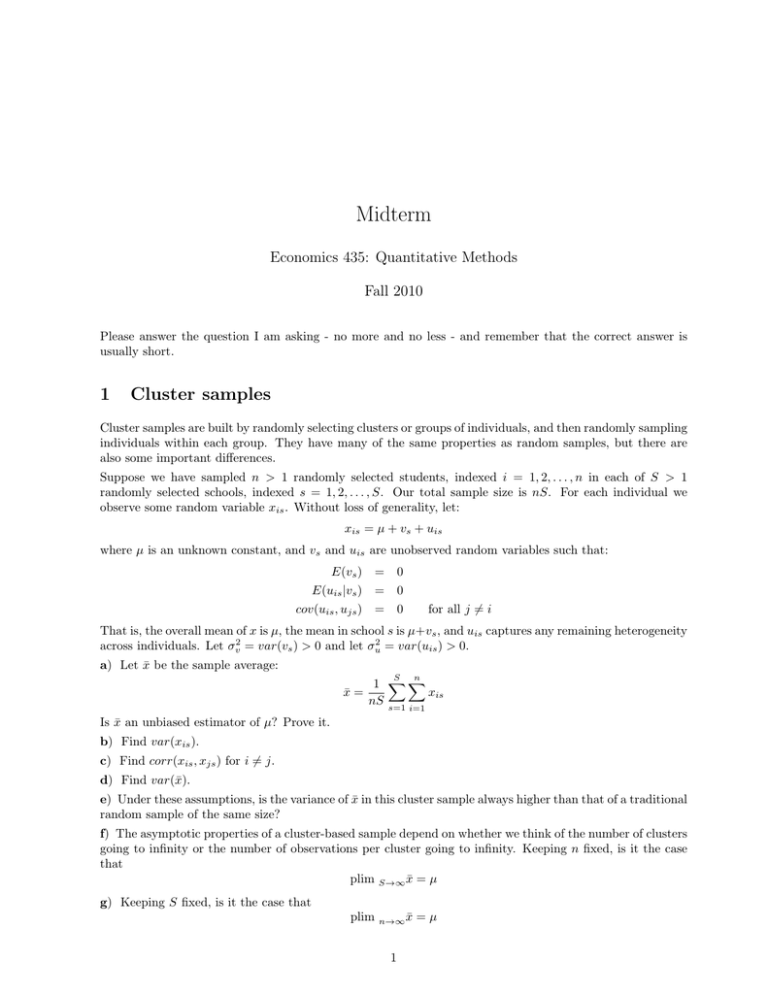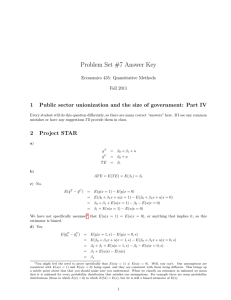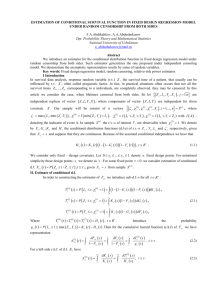Midterm Economics 435: Quantitative Methods Fall 2010
advertisement

Midterm Economics 435: Quantitative Methods Fall 2010 Please answer the question I am asking - no more and no less - and remember that the correct answer is usually short. 1 Cluster samples Cluster samples are built by randomly selecting clusters or groups of individuals, and then randomly sampling individuals within each group. They have many of the same properties as random samples, but there are also some important differences. Suppose we have sampled n > 1 randomly selected students, indexed i = 1, 2, . . . , n in each of S > 1 randomly selected schools, indexed s = 1, 2, . . . , S. Our total sample size is nS. For each individual we observe some random variable xis . Without loss of generality, let: xis = µ + vs + uis where µ is an unknown constant, and vs and uis are unobserved random variables such that: E(vs ) = 0 E(uis |vs ) = 0 cov(uis , ujs ) = 0 for all j 6= i That is, the overall mean of x is µ, the mean in school s is µ+vs , and uis captures any remaining heterogeneity across individuals. Let σv2 = var(vs ) > 0 and let σu2 = var(uis ) > 0. a) Let x̄ be the sample average: x̄ = S n 1 XX xis nS s=1 i=1 Is x̄ an unbiased estimator of µ? Prove it. b) Find var(xis ). c) Find corr(xis , xjs ) for i 6= j. d) Find var(x̄). e) Under these assumptions, is the variance of x̄ in this cluster sample always higher than that of a traditional random sample of the same size? f) The asymptotic properties of a cluster-based sample depend on whether we think of the number of clusters going to infinity or the number of observations per cluster going to infinity. Keeping n fixed, is it the case that plim S→∞ x̄ = µ g) Keeping S fixed, is it the case that plim n→∞ x̄ 1 =µ ECON 435, Fall 2010 2 2 Permanent income and the black-white test score gap This question is based on a recent working paper by Rothstein and Wozny (available at http://www. econ.sfu.ca/Seminars/SeminarPapers/rothstein_wozny_2ndpaper.pdf) by the same title. I have taken liberties with a few details of the paper to make a tractable exam question. Researchers in the economics of education have investigated various explanations for the large and persistent gap in academic achievement (as measured by scores on standardized tests) between black and white youth in the United States. The unconditional gap (i.e. the simple difference in average scores between the two groups) is moderate in kindergarten but widens to almost a full standard deviation in later grades. The substantive question considered by Rothstein and Wozny is whether the black-white test score gap is smaller (or possibly even zero) once we condition on family financial resources. That is, is the difference in average test score between black and white students with the same level of resources smaller than the unconditional difference? Suppose that each individual in the population (of U.S. grade 3 students) is characterized by the observable variables (s, b, p, c), where si is person i’s test score, bi is an indicator for whether she is black, ci is the current household income of her family, and p is the permanent household income1 of her family. We will assume that: s = β0 + β1 b + β2 p + u where E(u|b, p) = 0 (1) s = γ0 + γ1 b + γ2 c + v where E(v|b, c) = 0 (2) p where E(w|b, c) = 0 (3) = δ0 + δ1 b + δ2 c + w We will also assume that current income is just permanent income plus some random “noise” that is unrelated to any other variable: c=p+e where e is independent of (p, b, s). One useful implication of this is that E(u|b, c) = 0. Finally, we add some notation: Let θ = (β0 , β1 , β2 , γ0 , γ1 , γ2 , δ0 , δ1 ). a) The test score gap conditional on current income is defined as: GAP 1(C) = E(s|b = 1, c = C) − E(s|b = 0, c = C) Find GAP 1(C) in terms of the elements of θ b) The test score gap conditional on permanent income is defined as: GAP 2(P ) = E(s|b = 1, p = P ) − E(s|b = 0, p = P ) Find GAP 2(P ) in terms of the elements of θ c) Previous studies have measured GAP 1(C), the gap conditional on current income and found it wasn’t much smaller than the unconditional gap. Rothstein and Wozny would like to measure GAP 2(P ), the gap conditional on permanent income. However, they cannot estimate it directly because there are few data sets with both good test score data and good income data. They have two data sets, one with data on (s, b, c) and another with data on (b, c, p). Both data sets are different random samples from the same population and exhibit nontrivial variation in all variables (i.e, there are no exact linear dependencies). Let γ̂ = (γ̂0 , γ̂1 , γ̂2 ) 1 You may have heard Milton Friedman’s concept of “permanent income” described in one of your other classes. Here’s the idea: over short time periods people experience substantial income fluctuations due to temporary unemployment, time spent in school, parenting of small children, bonuses, etc. Friedman argued that people smooth their consumption over time, and so the primary determinant of current spending is not current income but rather the level of spending that can be sustained over one’s lifetime given one’s expected lifetime income path. For example, most university students have current income well below the poverty level, but much higher permanent income. ECON 435, Fall 2010 3 be the OLS estimator for γ = (γ0 , γ1 , γ2 ) using the first sample, and let δ̂ = (δ̂0 , δ̂1 , δ̂2 ) be the OLS estimator for δ = (δ0 , δ1 , δ2 ) using the second sample. Are these estimators consistent? d) Using the elements of γ̂ and δ̂, construct a consistent estimator for GAP 1(C). e) Using the elements of γ̂ and δ̂, construct a consistent estimator for GAP 2(P ). This one is hard, so here’s a hint: plug equation (3) into equation (1), and then rearrange so you have something that looks like equation (2). f) The estimates from the data are: γˆ1 = −0.426 γˆ2 δˆ1 = = −0.306 δˆ2 = 0.205 0.524 Using these estimates and your previous results, construct numerical estimates of GAP 1(C) and GAP 2(P ). g) Based on these results is the test score gap conditional on permanent income smaller than the gap conditional on current income?





